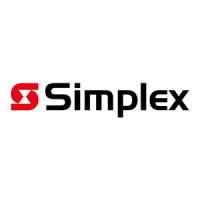8
• All wiring is 18 AWG (0.8231 mm
2
) (minimum) and 12 AWG (3.309 mm
2
) (maximum).
• All wiring is supervised and power-limited.
• All wiring that leaves the building requires overvoltage protection. Install the module
inside an UL-Listed electrical box wherever wire enters or exits the building. A
maximum of four 2081-9044 modules may be connected to one channel. The 2081-9044
is rated for 200 mA (maximum).
• For Class B (Style 4) operation:
- The maximum distance to any device is 2,500 feet (762 m).
- “T” taps are allowed.
- Total maximum cable load is 10,000 ft (3,048 m), including t-taps and all parallel c
connections. Use .29 pF/ Ft shielded cable to meet capacitance spec.
• For Style 4, 6 or 7 operation:
- The maximum allowed line-to-line capacitance (“+” to “-” terminals) is 0.58 uF.
- For applications with shielded wire, be sure that the total capacitance from line to
line plus the shield to either line is no more than 0.58 uF.
• For Class A (Style 6 or Style 7) operation, the maximum loop distance is 2,500 feet (762
m). “T” taps are not allowed.
• RUI comms are wired to remote cabinets from the CPU motherboard to the transponder
interface cards: 4100-0620 (566-093) or 4100-0625 (566-094).
• Transponder interface cards operate with a single open or a single short circuit when
wired Class A (Style 7).
• The master control panel must be a 4100U Fire Alarm Control Panel or a 4100 ES Fire Alarm
Control Panel.
• If 4602 and 4603 serial annunciators are present, circuit may be Style 4 or Style 6.
Annunciators do not isolate a short circuit fault, making Style 7 not possible.
• Up to 4 RUI cards in the 4100 Control Panel can be used for distributing transponder wiring
in different directions or for supporting different wiring requirements.
• Up to 31 transponders can be controlled from the 4100 Control Panel, and can be distributed
as required among the RUI cards.
System Guidelines
RUI Guidelines

